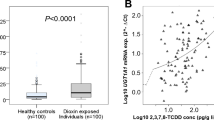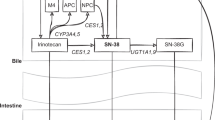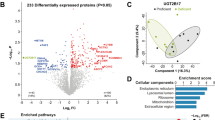Abstract
Uridine diphosphate-glucuronosyltransferase (UGT) 2B7 is expressed mostly in the human liver, lung and kidney and can transfer endogenous glucuronide group into its substrate and impact the pharmacological effects of several drugs such as estriol, AZT and morphine. UGT2B7 and its allelic variants can dimerize with the homologous enzymes UGT1A1 and UGT1A9, as well as their allelic variants, and then change their enzymatic activities in the process of substrate catalysis. The current study was designed to identify this mechanism using morphine as the substrate of UGT2B7. Single-recombinant allozymes, including UGT2B7*1 (wild type), UGT2B7*71S (A71S, 211G>T), UGT2B7*2 (H268Y, 802C>T), UGT2B7*5 (D398N, 1192G>A), and double-recombinant allozymes formed by the dimerization of UGT1A9*1 (wild type), UGT1A9*2 (C3Y, 8G>A), UGT1A9*3 (M33T, 98T>C), UGT1A9*5 (D256N, 766G>A), UGT1A1 (wild type) with its splice variant UGT1A1b were established and incubated with morphine in vitro. Each sample was analyzed with HPLC-MS/MS. All enzyme kinetic parameters were then measured and analyzed. From the results, the production ratio of its aberrant metabolism and subsequent metabolites, morphine-3-glucuronide (M3G) and morphine-6-glucuronide (M6G), changes regioselectively. Double-recombinant allozymes exhibit stronger enzymatic activity catalyzing morphine than the single-recombinant alloyzymes. Compared to UGT2B7*1, UGT2B7*2 singles or doubles have lower Km values for M3G and M6G, whereas UGT2B7*5 allozymes perform opposite effects. The double allozymes of UGT1A9*2 or UGT1A9*5 with UGT2B7 tend to produce M6G. Interestingly, the majority of single or double allozymes significantly reduce the ratio of M3G to M6G. The UGT1A9*2-UGT2B7*1 double enzyme has the lowest M3G:M6G ratio, reflecting that more M6G would form in morphine glucuronide metabolism. This study demonstrates that UGT2B7 common SNPs and their dimers with UGT1A1 and UGT1A9 and their allelic variants can regioselectively affect the generation of two metabolites of morphine via altering the CLint ratios of M3G to M6G. These results may predict the effectiveness of morphine antinociception in individualized opioid treatment.
Similar content being viewed by others
Log in or create a free account to read this content
Gain free access to this article, as well as selected content from this journal and more on nature.com
or
References
Ekström L, Johansson M, Rane A . Tissue distribution and relative gene expression of UDP-glucuronosyltransferases (2B7, 2B15, 2B17) in the human fetus. Drug Metab Dispos 2013; 41: 291–5.
Sadeque AJ, Usmani KA, Palamar S, Cerny MA, Chen WG . Identification of human UDP-glucuronosyltransferases involved in N-carbamoyl glucuronidation of lorcaserin. Drug Metab Dispos 2012; 40: 772–8.
Gall WE, Zawada G, Mojarrabi B, Tephly TR, Green MD, Coffman BL, et al. Differential glucuronidation of bile acids, androgens and estrogens by human UGT1A3 and 2B7. J Steroid Biochem Mol Biol 1999; 70: 101–8.
Bélanger AS, Caron P, Harvey M, Zimmerman PA, Mehlotra RK, Guillemette C . Glucuronidation of the antiretroviral drug efavirenz by UGT2B7 and an in vitro investigation of drug-drug interaction with zidovudine. Drug Metab Dispos 2009; 37: 1793–6.
Takeda S, Kitajima Y, Ishii Y, Nishimura Y, Mackenzie PI, Oguri K, et al. Inhibition of UDP-glucuronosyltransferase 2b7-catalyzed morphine glucuronidation by ketoconazole: dual mechanisms involving a novel noncompetitive mode. Drug Metab Dispos 2006; 34: 1277–82.
Nagaoka K, Hanioka N, Ikushiro S, Yamano S, Narimatsu S . The effects of N-glycosylation on the glucuronidation of zidovudine and morphine by UGT2B7 expressed in HEK293 cells. Drug Metab Pharmacokinet 2012; 27: 388–97.
Hwang MS, Lee SJ, Jeong HE, Lee S, Yoo MA, Shin JG . Genetic variations in UDP-glucuronosyltransferase 2B7 gene (UGT2B7) in a Korean population. Drug Metab Pharmacokinet 2010; 25: 398–402.
Lin GF, Guo WC, Chen JG, Qin YQ, Golka K, Xiang CQ, et al. An association of UDP-glucuronosyltransferase 2B7 C802T (His268Tyr) polymorphism with bladder cancer in benzidine-exposed workers in China. Toxicol Sci 2005; 85: 502–6.
Saeki M, Saito Y, Jinno H, Tanaka-Kagawa T, Ohno A, Ozawa S, et al. Single nucleotide polymorphisms and haplotype frequencies of UGT2B4 and UGT2B7 in a Japanese population. Drug Metab Dispos 2004; 32: 1048–54.
Sawyer MB, Pituskin E, Damaraju S, Bies RR, Vos LJ, Prado CM, et al. A uridine glucuronosyltransferase 2B7 polymorphism predicts epirubicin clearance and outcomes in early-stage breast cancer. Clin Breast Cancer 2016; 16: 139–44.
Zimmermann A, Blaszkewicz M, Roth G, Seidel T, Dietrich H, Schutschkow O, et al. UDP-glucuronosyltransferase 2B7 C802T (His268Tyr) polymorphism in bladder cancer cases. J Toxicol Environ Health A 2008; 71: 911–4.
Xu JM, Wang Y, Ge FJ, Lin L, Liu ZY, Sharma MR, et al. Severe irinotecan-induced toxicity in a patient with UGT1A1 28 and UGT1A1 6 polymorphisms. World J Gastroenterol 2013; 19: 3899–903.
Cruz JE, Saksena R, Jabbour SK, Nosher JL, Hermes-DeSantis E, Moss RA . The power of genes: a case of unusually severe systemic toxicity after localized hepatic chemoembolization with irinotecan-eluted microspheres for metastatic colon cancer. Ann Pharmacother 2014; 48: 1646–50.
Mehlotra RK, Bockarie MJ, Zimmerman PA . Prevalence of UGT1A9 and UGT2B7 nonsynonymous single nucleotide polymorphisms in West African, Papua New Guinean, and North American populations. Eur J Clin Pharmacol 2007; 63: 1–8.
Deng XY, Wang CX, Wang XD, Bi HC, Chen X, Li JL, et al. Genetic polymorphisms of UGT1A8, UGT1A9, UGT2B7 and ABCC2 in Chinese renal transplant recipients and a comparison with other ethnic populations. Pharmazie 2013; 68: 240–4.
Yuan L, Qian S, Xiao Y, Sun H, Zeng S . Homo- and hetero-dimerization of human UDP-glucuronosyltransferase 2B7 (UGT2B7) wild type and its allelic variants affect zidovudine glucuronidation activity. Biochem Pharmacol 2015; 95: 58–70.
Liu YQ, Yuan LM, Gao ZZ, Xiao YS, Sun HY, Yu LS, et al. Dimerization of human uridine diphosphate glucuronosyltransferase allozymes 1A1 and 1A9 alters their quercetin glucuronidation activities. Sci Rep 2016; 6: 23763.
De Gregori S, De Gregori M, Ranzani GN, Allegri M, Minella C, Regazzi M . Morphine metabolism, transport and brain disposition. Metab Brain Dis 2012; 27: 1–5.
Frances B, Gout R, Monsarrat B, Cros J, Zajac JM . Further evidence that morphine-6 beta-glucuronide is a more potent opioid agonist than morphine. J Pharmacol Exp Ther 1992; 262: 25–31.
Faura CC, Olaso MJ, Garcia Cabanes C, Horga JF . Lack of morphine-6-glucuronide antinociception after morphine treatment. Is morphine-3-glucuronide involved? Pain 1998; 65: 25–30.
Ouellet DM, Pollack GM . Effect of prior morphine-3-glucuronide exposure on morphine disposition and antinociception. Biochem Pharmacol 1997; 53: 1451–7.
Bastami S, Gupta A, Zackrisson AL, Ahlner J, Osman A, Uppugunduri S . Influence of UGT2B7, OPRM1 and ABCB1 gene polymorphisms on postoperative morphine consumption. Basic Clin Pharmacol Toxicol 2014; 115: 423–31.
Sawyer MB, Innocenti F, Das S, Cheng C, Ramírez J, Pantle-Fisher FH, et al. A pharmacogenetic study of uridine diphosphate-glucuronosyltransferase 2B7 in patients receiving morphine. Clin Pharmacol Ther 2003; 73: 566–74.
Al Saabi A, Allorge D, Sauvage FL, Tournel G, Gaulier JM, Marquet P, et al. Involvement of UDP-glucuronosyltransferases UGT1A9 and UGT2B7 in ethanol glucuronidation, and interactions with common drugs of abuse. Drug Metab Dispos 2013; 41: 568–74.
Ohno S, Kawana K, Nakajin S . Contribution of UDP-glucuronosyltransferase 1A1 and 1A8 to morphine-6-glucuronidation and its kinetic properties. Drug Metab Dispos 2008; 36: 688–94.
Wang H, Yuan L, Zeng S . Characterizing the effect of UDP-glucuronosyltransferase (UGT) 2B7 and UGT1A9 genetic polymorphisms on enantioselective glucuronidation of flurbiprofen. Biochem Pharmacol 2011; 82: 1757–63.
Laakkonen L, Finel M . A molecular model of the human UDP-glucuronosyltransferase 1A1, its membrane orientation, and the interactions between different parts of the enzyme. Mol Pharmacol 2010; 77: 931–9.
Lévesque E, Delage R, Benoit-Biancamano MO, Caron P, Bernard O, Couture F, et al. The impact of UGT1A8, UGT1A9, and UGT2B7 genetic polymorphisms on the pharmacokinetic profile of mycophenolic acid after a single oral dose in healthy volunteers. Clin Pharmacol Ther 2007; 81: 392–400.
Nakajima M, Yamanaka H, Fujiwara R, Katoh M, Yokoi T . Stereoselective glucuronidation of 5-(4′-hydroxyphenyl)-5-phenylhydantoin by human UDP-glucuronosyltransferase (UGT) 1A1, UGT1A9, and UGT2B15: effects of UGT-UGT interactions. Drug Metab Dispos 2007; 35: 1679–86.
Bichlmaier I, Siiskonen A, Finel M, Yli-Kauhaluoma J . Stereochemical sensitivity of the human UDP-glucuronosyltransferases 2B7 and 2B17. J Med Chem 2006; 45: 1818–27.
Sten T, Qvisen S, Uutela P, Luukkanen L, Kostiainen R, Finel M . Prominent but reverse stereoselectivity in propranolol glucuronidation by human UDP-glucuronosyltransferases 1A9 and 1A10. Drug Metab Dispos 2006; 34: 1488–94.
Tougou K, Gotou H, Ohno Y, Nakamura A . Stereoselective glucuronidation and hydroxylation of etodolac by UGT1A9 and CYP2C9 in man. Xenobiotica 2004; 34: 449–61.
Court MH, Duan SX, Guillemette C, Journault K, Krishnaswamy S, Von Moltke LL, et al. Stereoselective conjugation of oxazepam by human UDP-glucuronosyltransferases (UGTs): S-oxazepam is glucuronidated by UGT2B15, while R-oxazepam is glucuronidated by UGT2B7 and UGT1A9. Drug Metab Dispos 2002; 30: 1257–65.
Acknowledgements
This study was supported by the International Science & Technology Cooperation Program of China (No 2014DFE30050); Program for Zhejiang Leading Team of S&T Innovation Team (No 2011R50014); Natural Science Foundation of Zhejiang Province (No LQ15H310003); and Fundamental Research Funds for the Central Universities of China Ministry of Education (No 2016XZZX001-08).
Author information
Authors and Affiliations
Corresponding authors
Rights and permissions
About this article
Cite this article
Yang, Zz., Li, L., Wang, L. et al. The regioselective glucuronidation of morphine by dimerized human UGT2B7, 1A1, 1A9 and their allelic variants. Acta Pharmacol Sin 38, 1184–1194 (2017). https://doi.org/10.1038/aps.2016.157
Received:
Accepted:
Published:
Issue date:
DOI: https://doi.org/10.1038/aps.2016.157
Keywords
This article is cited by
-
Insight into the structure, oligomerization, and the role in drug resistance of human UDP-glucuronosyltransferases
Archives of Toxicology (2025)
-
Ursolic acid attenuates cholestasis through NRF2-mediated regulation of UGT2B7 and BSEP/MRP2
Naunyn-Schmiedeberg's Archives of Pharmacology (2024)
-
High fat diet significantly changed the global gene expression profile involved in hepatic drug metabolism and pharmacokinetic system in mice
Nutrition & Metabolism (2020)



